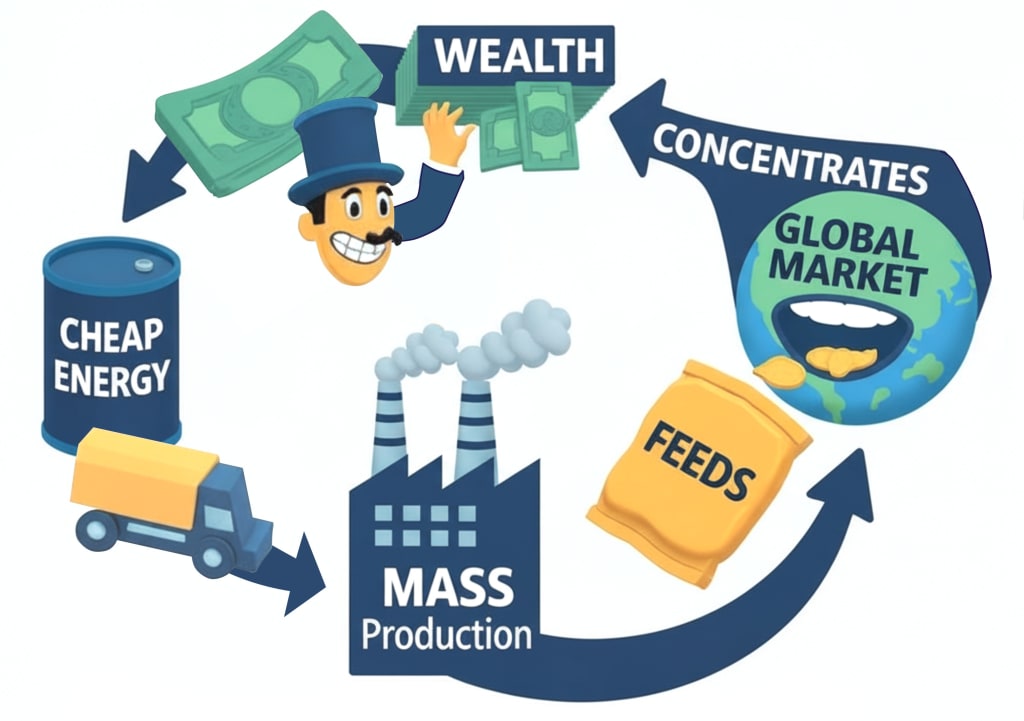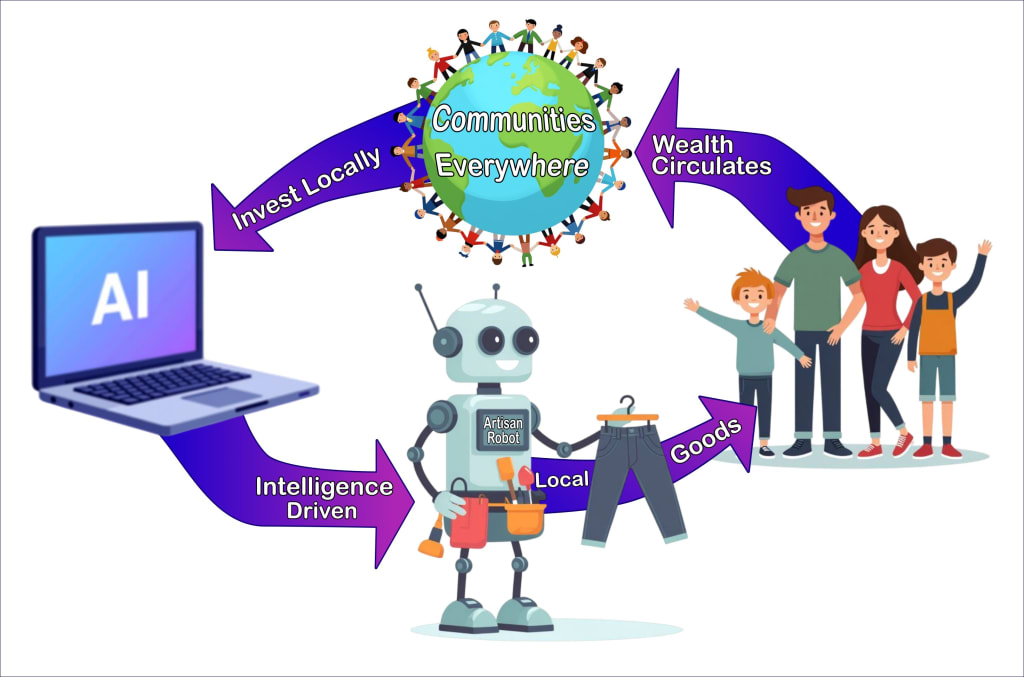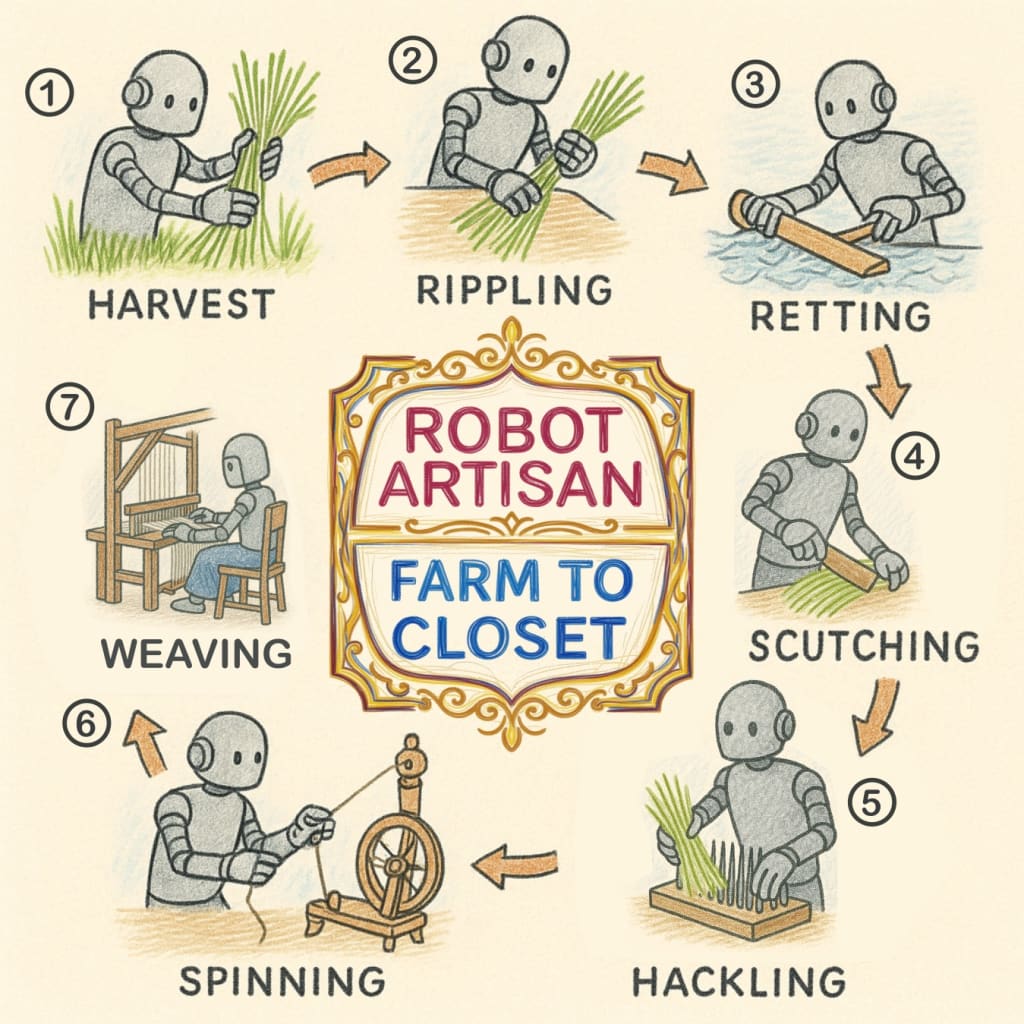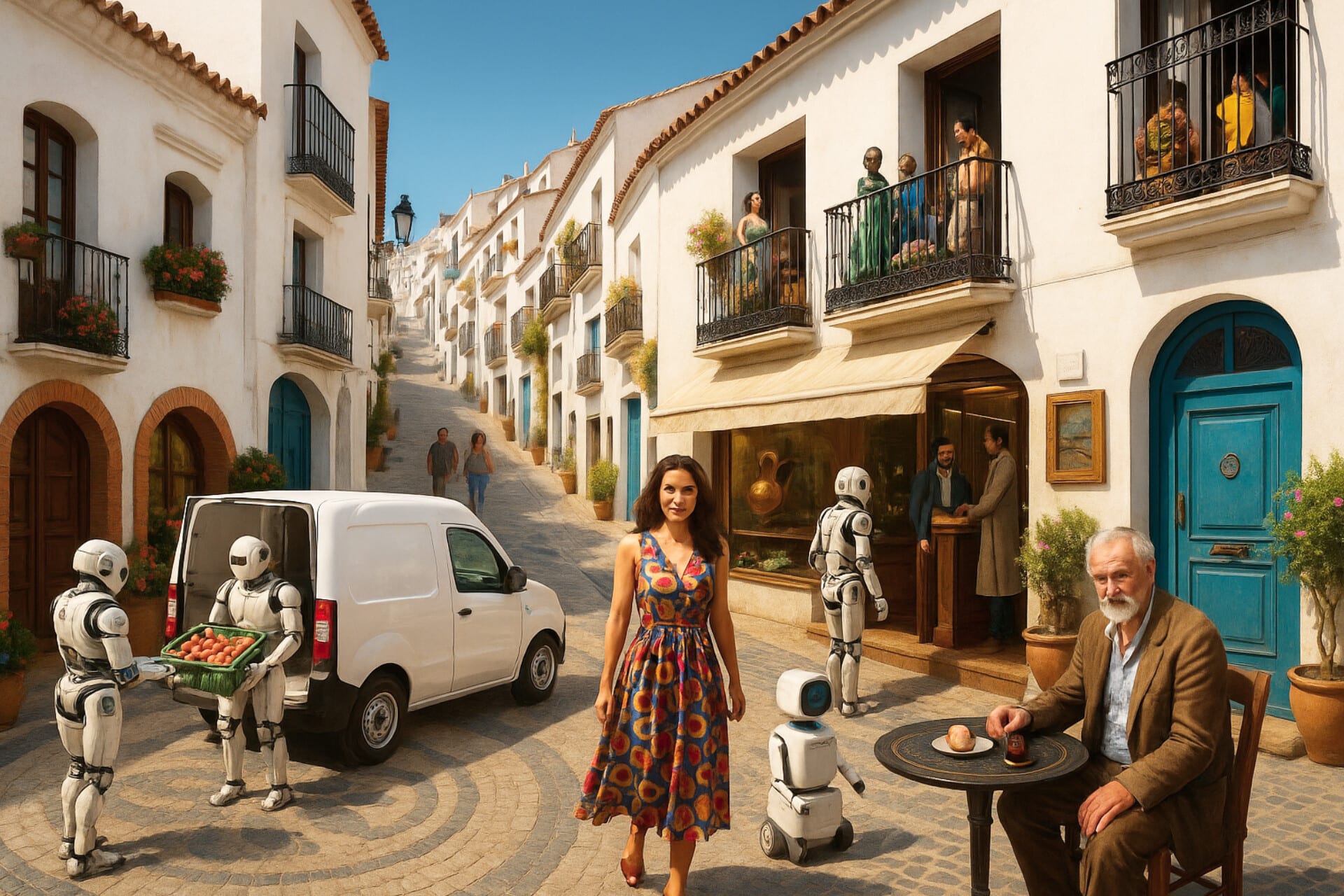Imagine walking down a narrow street of Spanish-style buildings, passing flowers and colorful doors rhythmically. Bright-eyed people stroll by, walking on stones creating elaborate patterns in the road. Robots scurry unobtrusively, delivering goods and keeping everything immaculate.
In shop windows, the latest styles are displayed: elaborately crafted furniture, jackets fit for rock-stars, dresses for Victorian Queens. You pass a designer consulting with his team of AIs about the best style for a customer, as a robot in the back takes measurements with laser precision.
The aroma of fresh pastries fills the street and you greet your neighbor sitting at a cafe with no human staff. A voice from the table offers you your favorite drink, but there’s something you’re driven to do first.
A short walk away, you step into a small shop. The full range of the artisan’s potential is on display around you. Through a half open curtain you peer into the workshop where a mix of hand tools, modern equipment, and robotic arms are busy at work.
The smiling proprietor comes downstairs with a waft of savory scents that momentarily overcome the pungent workshop air.
With a methodical presence, the artisan listens to your desires, prompting for details as you point to various features of his previous work.
With an easy agreement on price, an extra set of arms comes alive in the workshop.
Everything is made here, from materials grown & gathered nearby. Not only in this artisans workshop, but in all the production facilities in this entire community. There are no middlemen or foreign suppliers. That means all the wealth produced from this community’s commerce stays here. It is all spent and distributed according to the community’s values.
This is the world we will soon be able to create.
The Old Loop
For 200 years, the foundation of our economy has been cheap energy. Coal driven steam engines evolved into petroleum powered generators, turning factories, assembly lines, & global supply chains.
Without cheap fuel, there is no logic to our industrial economy. We’ve set up factories to produce goods for customers on the other side of the planet. We’ve built skyscraper sized boats that measure their fuel in tons burned per hour to transverse entire oceans to close the gap between producer and consumer. We’ve taken some of the nicest bay-side real estate around the world and turned those places into industrial ports to accommodate this way of doing business.
The one and only reason this makes sense is cheap fuel.
Basing our economy on cheap fuel has created a feedback loop that concentrates wealth, homogenizes cultures, and encourages the exploitation of people and ecosystems around the world.
The cheap fuel economic loop goes like this:
- Cheap energy powers mass production.
- Mass production feeds global markets.
- Global markets funnel wealth into fewer hands.
- That concentrated wealth is spent on infrastructure that can further leverage cheap fuel.

Then the loop begins again. As this cycle turns, greater wealth and power are concentrated to fewer companies, governments, and individuals.
Whether under capitalism or communism, the logic has always been the same: grow forever, aim for the entire market-share, and pull resources from wherever they are cheapest.
It “works”, as we all know, but only for a fraction of the population, and at tremendous cost to the people and ecologies this process depends on.
The New Ingredient
AI changes the game. It’s not simply another communications upgrade like the internet or smartphones. It’s the engine that kicks off the Intelligence Revolution.
Brute force is the primary advantage of petroleum and the main ingredient turning our economy. AI is an intellectual form of power that will offer a new economic design. Instead of transforming fuel into strength via big machines, AI transforms knowledge into quality decision-making, which can guide nuanced machines to do specialized work.
Leveraging technology is a 2 step process.
First you must acquire the technology. Anyone with a credit card can achieve this.
Second, you must properly use the technology. This can be exceptionally more difficult.
For example, you could buy a computer today, no problem. But programming new software to get that computer to do something unique could require a team of developers working for months.
Robotics is the pinnacle example. We’ve had mature robotics technology for decades. You can buy a basic robot arm for a few hundred dollars, but then you must program it to do meaningful work.
Programming robotics has been so complex and expensive, they’re near exclusive application has been in factories where they can be leveraged to offset millions of dollars in labor.
Their main issue is, they can’t adapt. Therefore, robotics have only been effective in meticulously organized situations; if conditions are not exactly as the bot expects, it fails.
If there’s a slightly dynamic decision to make, the solution has been to stick a button on the machine and put a human in charge.
But now AI can perform adaptive logic to make dynamic decisions. AI is like a translator between humanity and all our complicated digital technology. It can take plain language requests, along with visual or audio guides, grasp the context of the situation and control a machine without using buttons and levers.
Fast Moving Robotics
In the beginning of 2025, amateur robotic arm enthusiasts were able to train their own specific robotic arm to pick up a specific block and put it in a specific container. It took hands-on replications of the movement and hours of inference on top shelf consumer computers to pull it off.
Just 9 months later, you could download a pre-trained program that will enable most robotic arms to pick up many different objects, open most drawers and put the object inside. And it could do it running on your old laptop.
Within the year, the technology was taken from being a painstaking novelty, to doing practical work. Not by a corporation with billions in funding; by a loose knit open-source community.
The result will soon be entirely free libraries of actions enabling various robotics to respond to verbal commands.
This open-source robotics movement illustrates the speed and direction this is headed. There are of course commercial humanoid robots rolling off assembly lines, set for consumer application.
Prediction
In the next couple of years, many people will buy their own domestic robot. It will clean up after them, fold laundry, and act like a housekeeper & butler. Eventually, what will stand out to owners is how quickly the robot gets everything done and then just stands around.
Folks will brainstorm with AI to come up with productive work to keep their bots busy. Home meals will become extravagant works of art. Living room walls will become family murals. Yards will transform into extraordinary gardens or productive micro farms.
Any hobby or craft curiosity can be quickly pushed to the max with AI supported robotic assistance. Tinkerers and hobbyists will become designers and producers. The average dreamer who lacks the ability to materialize what they imagine, will be able to utilize this digital expertise to manifest their dreams. Fantastic new styles and affordable possibilities will inspire a material Renaissance.
People will realize, the reason we stopped producing artisan crafted goods was the skilled labor required to produce them. We’ve always generally preferred artisan crafted goods. Their one and only problem is the price tag.
Mass produced goods can be 98% cheaper than the handcrafted versions. When the Industrial Revolution offered humanity its discounted goods, we bought them and became materially rich. Few artisans could compete.
But now, robots are poised to be able to perform skilled labor around the clock for minimal cost. The precise actions of an artisan’s hand will soon be downloadable into your housebot, who will labor endlessly in its “free time” without complaint beyond drained batteries and occasional maintenance.
The New Loop
The economics flip: local workshops can compete with global factories; not by mass-producing more junk, but by producing higher quality, personalized products at the same cost.
When production runs on intelligence instead of raw energy, the cycle changes.
- Cheap intelligence enables efficient local production.
- Local workshops serve their own communities directly.
- Profits stay nearby, circulating around the local economy.
- Communities are incentivized to invest in themselves.

With every cycle, the community becomes more prosperous and robust. Instead of wealth concentrating, it continues being spent in the community. Instead of factories burning fuel to ship the same plastic product across the world, local systems use regional materials to make exactly what customers want, with minimal waste.
How Local Wins
Let’s say you need new pants in this not so distant future. The first decision to make is, factory pants or artisan pants? Are you going to buy them from a big box store, or are you going to get them tailor made locally.
The old store offers several styles, in a few sizes, as always. It’s quick and impersonal, but that’s the main advantage.
The alternative is one of the local tailors who make custom pants. They can do the standard styles, but their pants will fit better because they’re based off of a dozen personal measurements, instead of generic waste and length sizes.
The temptation with the tailor is to customize, as the tailor offers numerous styling options. For a bit more, a tailor will alter the color, add pockets, zippers, embroidery, or rhinestones, however you’d like. They offer style combinations never before created in a factory. And everything always fits perfectly since it’s made for your body.
With local automation, the tailor’s costs are greatly reduced. The primary cost of artisan made goods is labor. But with AI driven robotics, that cost becomes the price of inference & maintaining the robotic crew.
Unlike products made in overseas factories, locally made-to-order goods don’t require long-haul trucks, warehousing, cargo ships, customs, or logistics. The tailor doesn’t need a national marketing campaign to appease investors – who will also be wanting their cut – that the inventory will indeed be desired and enough will sell to turn a profit. With the artisan approach, inventory waste is minimized, customer feedback is immediate, & product issues are repaired instead of returned. The effort and costs go into producing the product, instead of marketing & shipping it across the world.
Mass producing means mass investing and returns on those investments can take a long time. The artisan’s cash cycle is tight, as finished work is paid for promptly. This reduces risk. Since the cost of an artisan’s tools is modest compared with the industrialized version, the barriers to entry will be relatively low.
Raw materials will also be subsidized by robotic labor. As labor costs drop , transportation costs will relatively increase, and the least expensive option will be the most local option.
Tailors may find a farm-to-closet approach most lucrative, growing their own cotton, flax, hemp, or even silk, with their robot crew putting in the labor intensive effort to turn these raw fibres into fabrics. As has been the norm for most of humanity’s existence, people will once again clothe themselves in local fibres.

Choose Your Own Values
Mass production locks us into mass culture. To sell to millions, a company must design for average tastes. What will the most customers tolerate?
That leads to beige couches, grey cars, standard flavors, and many options with only slight variations, because they must be designed for average tastes & mass adoption. Catering to niche desires is simply too expensive for the industrial business model.
But when production is local, the equation flips. Artisans don’t have to guess at what millions might want. They have the luxury of producing exactly what they’re customers request.
Instead of choosing one design and producing many, an artisan can produce single examples of many different designs for their customers to choose from.
When the full scope of crafting options are available for the customer to request, normal people will be empowered to bring their imagination to life. People will be able to sketch out their dream outfit, furniture or home with AI assistance, and have it locally made at an affordable price.
Then, instead of culture being dictated by corporations, culture becomes participatory. Local people shape it. What you choose may inspire those around you, causing local styles to emerge. Culture stops being a factory export and becomes an organic expression of local tastes, like it was before global industrialization.
Beyond the facades of culture, this enlivened artisan economy will empower communities to better express their values. When production is local, money stays local, and communities become wealthy. When a community pays for their own infrastructure instead of taking government funding, they are not bound by the stipulations of the funding.
That Spanish-style market neighborhood described at the beginning of this article would not qualify for public funding in the United States. The mosaic road breaks Federal street-marking conventions. The lack of separation between roadway and walkway is against compliance.
Like funding denied for schools that teach theology, if a community wants to build that Spanish style street, it will need to fund the project entirely locally. The only way to side step these limitations is with local economic might.
By leveraging AI powered automation, local communities everywhere can grow wealthy, culturally diverse, and better express their values. We will redefine prosperity and carve out niche communities focused on modalities of fulfillment.
Communities will be able to differentiate themselves like never before. People will be able to express their values in the foundational design of their communities.
A group that deeply values environmentalism could design a community without streets that only uses environmentally friendly goods. If everything is produced locally, you don’t need giant delivery trucks, which means you don’t have to build the roads and infrastructure to accommodate them. This community could choose to incorporate nature into their built spaces for a lifestyle that steps softly on the planet.
Another community might embrace art and aesthetics, aiming to design the most beautiful & mesmerizing spaces. Every building, an architectural wonder. Every surface, a work of art. No distinction between clothing and costume. The community could be an immersive artistic experience, supported by robotic labor.
Modern monastic communities could establish with their own mix of modalities, given the lowered cost to create. Mud and stone can be transformed into libraries and temples, when intelligence and labor are inexpensive.
Grand coliseums will be built in communities devoted to sport. Adventurers living in hermetically sealed communities will establish themselves in the desert as practice for Mars. Like the Amish, groups will pick a romanticized style from a specific era, add AI robotics to the scope of what is acceptable, then build and live in their dream community.
Transitioning to Intelligence
For two centuries, the story of progress has been written in coal dust, oil fumes, and shipping routes. We gained abundance, but at the cost of local fragility, inequality, and ecological ruin. Cheap energy gave us factories, and factories gave us mass markets, but those markets hollowed out communities and left us chasing sameness.
Now, a new loop is forming. Cheap, adaptable, distributed intelligence will change the foundation of production. Where energy demands scale, intelligence thrives on nuance. Where factories demanded conformity, intelligence enables personalization. Where wealth once pooled at the top, it will soon circulate within the community.
The result will shift our economics and allow us to diversify our values. Communities will have the power to choose what to produce, how to design, and where to invest. Culture will no longer be standardized by distant corporations, but grown locally, shaped by people for themselves. Streets, schools, goods, and gatherings can reflect the character of those who live there, instead of the agendas of advertisers and corporations.
This is not utopia delivered from above buy a global power. It’s prosperity built locally from the foundation up. It’s not about an ever greater magnitude of growth, but about growth in the direction of our choosing, determined by each community.
We are at a rare hinge of history: moving from energy to intelligence, from mass production to local creation, from centralized wealth to distributed prosperity. This is the natural result as the core input of our economy shifts from energy to intelligence.The artisan’s workshop, empowered by robotics and AI, will be the seed of local autonomy.
The future is not something to wait for. It is something to build in your garage and share with your neighbor. The corporations will try to shape it, but the local offerings will be superior. Governments will demand it their way, but local communities will need them like they need the monarchies of the past.
Our future has already been open-sourced at open-throttle. The question you must ask yourself is, what world do you want to accelerate towards?
